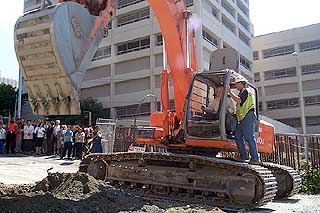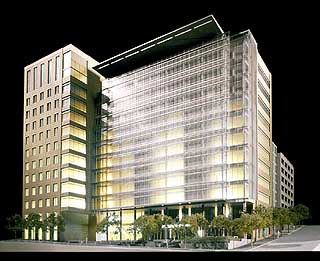|
Subscribe / Renew |
|
|
Contact Us |
|
| ► Subscribe to our Free Weekly Newsletter | |
| home | Welcome, sign in or click here to subscribe. | login |
Architecture & Engineering
| |
July 20, 2000
Eco-friendly Justice Center
Journal Staff reporter
Jean Rietschel says she has put up long enough with the injustices of the city's 50-year-old Public Safety Building.

|
"I'm really looking forward to the amenities of the new building," said Rietschel, presiding Municipal Court judge. To the applause of many co-workers who attended Wednesday's groundbreaking for the new Justice Center, Rietschel rattled off a few examples of what she won't miss.
"We will have air conditioning that actually works," she said. "We'll have elevators that don't stop between floors; an express payment counter; attorney-client conference rooms; a separate elevator for court-custody defendants; and a children's waiting room."
The $92 million Justice Center, on Fifth Avenue between James and Cherry streets, will be part of the $226 million Civic Center. Construction on the Justice Center begins this summer and will be complete in summer of 2002. NBBJ is the architect, and Hoffman Construction is the general contractor. Gusftafson Partners, with Swift & Co. Landscape Architects, are landscape designers. City Hall, to be complete by late 2002, is being designed by Bassetti Architects and Bohlin Cywinski Jackson.
The 300,000-square-foot Justice Center will house 800 employees and have 165,000 square feet for courts and 135,000 square feet for police, with a total of 13 floors.
NBBJ's design responds to the differences between the needs of the police and judicial staff. The southern portion of the building has a primarily glass facade and will house the judicial space, while the northern portion, primarily masonry, will house the police portion.
The building also promotes responsible stewardship of natural resources by achieving a "Silver" LEED (Leadership in Energy and Environmental Design) rating from the U.S. Green Building Council. Sustainable elements include a large section of the west facade that has been designed as a naturally vented "double-skin" facade. The intent is to allow maximum penetration of natural light while minimizing heat gain. The "green roof" will add insulation value, provide absorption and storage of rainwater and create a space to filter pollutants.

|
The courts portion of the building will be set back 34 feet to allow for a plaza, steps and landscaping to reflect the public nature of the courts side. The courts' entry is located off the plaza, while the police entry is smaller and more discrete.
The Civic Center -- which will be complete in 2004 -- will include a $72 million City Hall; $14 million for open space; $24 million for renovations and improvements to Key Tower; and $9 million for seismic improvements to the Arctic Building. Councilmanic debt and the sale of the Dexter Horton and Alaska buildings will pay for most of the $226 million cost. The city estimates it will save $3 million annually by replacing older buildings with more cost-efficient ones.


